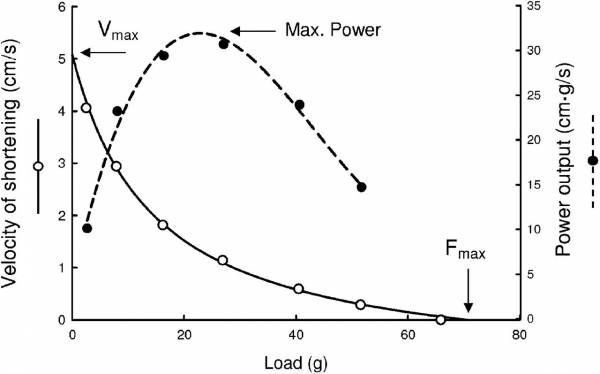Source: Bruce Klemens
Source: Bruce Klemens
With absolute strength being the physiological limit that defines the ability for an athlete to produce power, the optimal rate of force development is achieved by increasing speed. Paraphrasing Dr. Fred Hatfield developing athleticism means to develop strength – muscular strength – while increasing speed.
The combination of both corresponds to a specific point along the force-velocity curve, described by Archibald Vivian Hill in 1926, that defines performance in terms of peak power output (PPO). The function f(P) – power, the time derivative of work – normally sits on the left-end side of the force-velocity curve, confirming the importance of absolute strength in producing the greater power output. At any given percentage of Fmax (maximal isometric strength, according to the most traditional standards in the academic literature, 1RM according to the more recent guidelines).

Olympic-style weightlifting movements have been shown to produce greater power output than any other conventional resistance training exercise; PPO in the snatch, the clean, and their main derivatives (pulls and extensions) ranges between 75 and 85% of 1RM with speed – bar speed – reaching approximately 2-2.5. m/sec. Almost twice the speed recommended to develop speed-strength, the most athletic-like expression of absolute strength.
According to Dr. Bryan Mann, “speed-strength […] includes velocities ranging from about 1.0 to 1.3 meters per second, depending on the amplitude of motion. The Olympic lifts may have a much higher velocity as the bar has to move much farther”
By manipulating the variable d (displacement) – the incognita in the function f(P) as P represents the rate of change in work (Fxd) over time (t) also known as rate of force development (RFD) – Olympic-style weightlifting exercises display a longer bar path than any other traditional resistance training exercise, a mechanical feature that allows force to be applied against the ground over a longer period of time producing more speed throughout the entire range of motion.
It is therefore important for high school and collegiate athletes to learn the correct line of pull, the (quasi)linear distance between the point of maximal inertia (the starting position) and the point of minimal inertia (the catch). Pulls from the blocks, three positions snatches and cleans, and halting deadlifts are great exercises to develop strength and power while learning the proper pulling mechanics.
For more advanced athletes, power snatches and power cleans represent an interesting solution to further increase overall vertical displacement by receiving the bar in the power position.
Reference
1. Harbili, E., & Alptekin, A. (2014). Comparative Kinematic Analysis of the Snatch Lifts in Elite Male Adolescent Weightlifters. Journal of Sports Science & Medicine, 13(2), 417.






